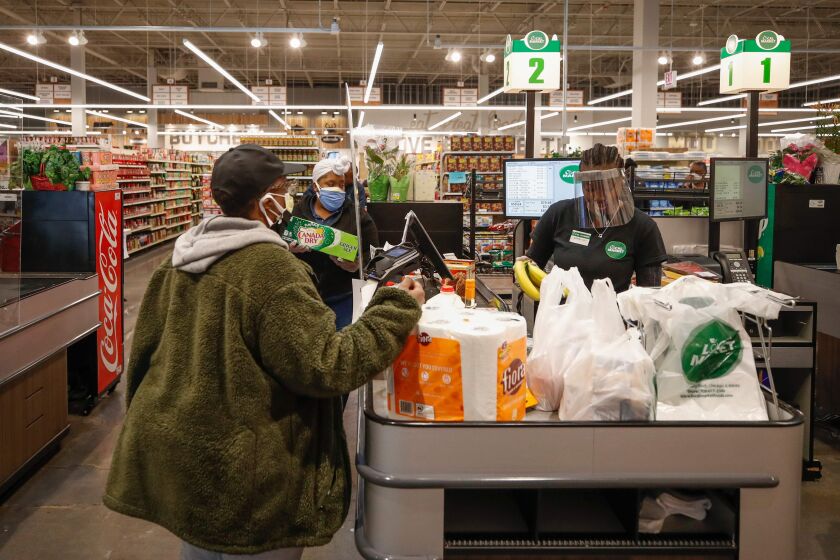The salad bar, the soup bar, the olive bar. The free samples. The leisurely time spent strolling through the produce section, touching avocados to check whether they’re fresh.
All of that’s vanished during the coronavirus pandemic, which has turned a trip to the grocery store into a monumentally stressful experience for many shoppers.
Like other catastrophes, the havoc left by the coronavirus will leave us with lasting changes affecting all aspects of our lives, groceries no exception.
“People used to love going to the stores and seeing their friends,” says Phil Lempert, founder of SupermarketGuru.com and consultant and TV analyst who’s followed grocery shopping trends for three decades. “A lot of that is over.”
Lempert expects to see changes in the design of grocery stores as well as changes in how we buy products.
Sanitation will be at the top of the list for stores, with Plexiglas cashier stands continuing to be the norm, along with innovations like antimicrobial checkout belts and hand-sanitizing stations.
Aisles will be made wider so shoppers don’t feel crammed in, and contactless payments will be encouraged.
In the produce section, expect to see more prepackaged items, Lempert says. He thinks post-pandemic consumers will not look kindly on people who squeeze the cantaloupes and oranges before putting them back in the display.
But the biggest change might be how drastically the number of products on shelves is reduced. Today, a typical supermarket stocks about 42,000 different items. Lempert envisions a hybrid experience in which shoppers go online to choose staple items — such as ketchup, breakfast cereal and dish soap — and then shop in person only for produce, meat, fish, bread and other fresh items that require a closer look.
And while the customer is shopping, robotics at the back of the store would gather the products from the online list and bring the order to the front of the store. When the shopper brings the fresh items to the checkout stand to pay, the cashier would add the goods ordered online.
Shoppers would be in and out much more quickly, a vastly more efficient experience.
That scenario would eliminate the salad bar, which Lempert says created a lot of waste for stores anyway. “I think the entire store is going to be reimagined,” he says.
Consumers seem poised for more digital shopping. During the pandemic, delivery and “click-and-collect” shopping — the consumer orders and pays online, then picks up food at the store — “has gone through the roof,” Lempert says.
Albertons CEO Vivek Sankaran told investors in April that the parent company of Jewel-Osco will continue investing in e-commerce. “We’ve had the plans, so now it’s a matter of accelerating those investments commensurate with the growth that we are seeing in e-commerce.”
Already, some supermarket chains have created “ghost grocery” locations — fulfillment centers that are closed to the public except for click-and-collect orders.
The pandemic also exposed the fragility of supply chains for items such as meat and toilet paper, areas in which smaller, nimbler grocery stores might be able to excel. Many independent grocers had better luck stocking popular products because of their longstanding relationships with local farmers and suppliers, says Laura Strange, spokeswoman for the National Grocers Association, which represents independent supermarket operators and wholesalers.
When the virus hit, smaller operations were able to quickly pivot to e-commerce and contactless payment methods and put sanitation protocols in place to assure their customers, Strange says.
One small grocer in California called a portable toilet company to quickly set up a hand-washing station for customers to use as they entered and exited the store.
“They adjusted their operations and shifted to be sure they were providing a safe environment for their customers and their employees,” Strange says.
She also thinks salad bars and hot food bars will disappear for now, though she doesn’t rule out a comeback after there’s a vaccine or drug therapy for COVID-19.
The big winners for now are likely to be “grab-and-go” prepacked deli items and meal kits that will allow people to dine at home ,where they feel safe, eating food that’s easy to prepare.
As with the 2008 recession, money concerns will have shoppers looking for the best values, Strange says, which means private-label products will do well, as will locally sourced items that people want to support.








